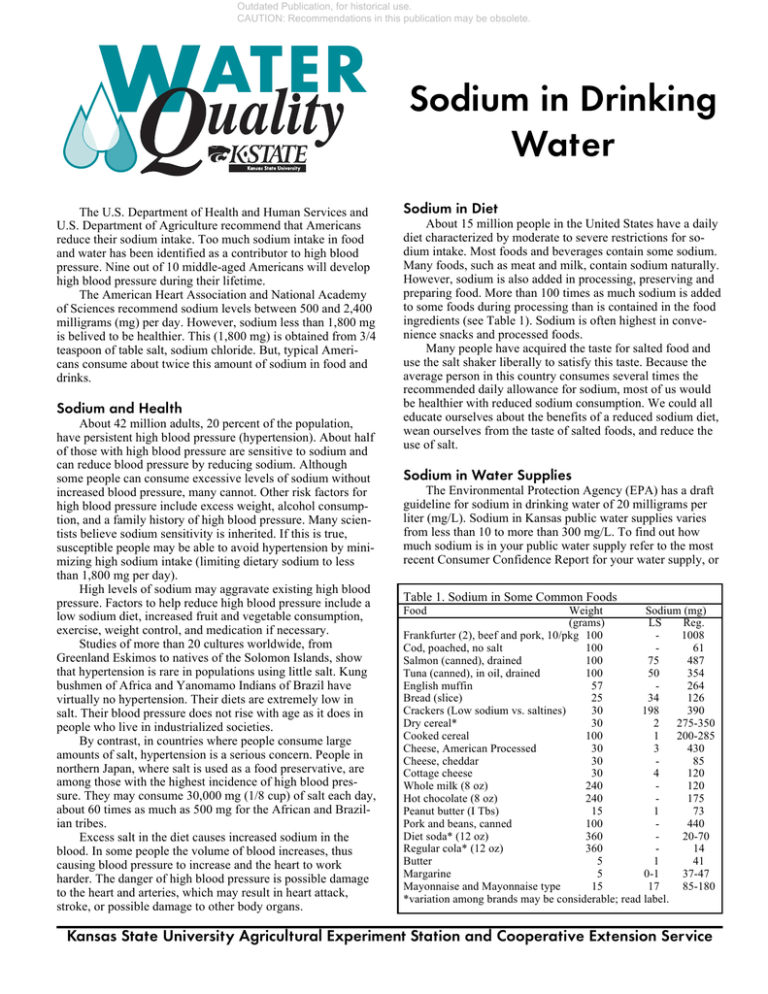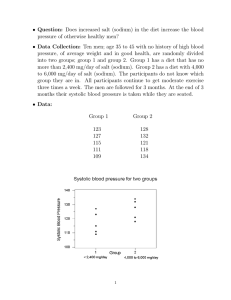
Outdated Publication, for historical use.
CAUTION: Recommendations in this publication may be obsolete.
Sodium in Drinking
Water
The U.S. Department of Health and Human Services and
U.S. Department of Agriculture recommend that Americans
reduce their sodium intake. Too much sodium intake in food
and water has been identified as a contributor to high blood
pressure. Nine out of 10 middle-aged Americans will develop
high blood pressure during their lifetime.
The American Heart Association and National Academy
of Sciences recommend sodium levels between 500 and 2,400
milligrams (mg) per day. However, sodium less than 1,800 mg
is belived to be healthier. This (1,800 mg) is obtained from 3/4
teaspoon of table salt, sodium chloride. But, typical Americans consume about twice this amount of sodium in food and
drinks.
Sodium and Health
About 42 million adults, 20 percent of the population,
have persistent high blood pressure (hypertension). About half
of those with high blood pressure are sensitive to sodium and
can reduce blood pressure by reducing sodium. Although
some people can consume excessive levels of sodium without
increased blood pressure, many cannot. Other risk factors for
high blood pressure include excess weight, alcohol consumption, and a family history of high blood pressure. Many scientists believe sodium sensitivity is inherited. If this is true,
susceptible people may be able to avoid hypertension by minimizing high sodium intake (limiting dietary sodium to less
than 1,800 mg per day).
High levels of sodium may aggravate existing high blood
pressure. Factors to help reduce high blood pressure include a
low sodium diet, increased fruit and vegetable consumption,
exercise, weight control, and medication if necessary.
Studies of more than 20 cultures worldwide, from
Greenland Eskimos to natives of the Solomon Islands, show
that hypertension is rare in populations using little salt. Kung
bushmen of Africa and Yanomamo Indians of Brazil have
virtually no hypertension. Their diets are extremely low in
salt. Their blood pressure does not rise with age as it does in
people who live in industrialized societies.
By contrast, in countries where people consume large
amounts of salt, hypertension is a serious concern. People in
northern Japan, where salt is used as a food preservative, are
among those with the highest incidence of high blood pressure. They may consume 30,000 mg (1/8 cup) of salt each day,
about 60 times as much as 500 mg for the African and Brazilian tribes.
Excess salt in the diet causes increased sodium in the
blood. In some people the volume of blood increases, thus
causing blood pressure to increase and the heart to work
harder. The danger of high blood pressure is possible damage
to the heart and arteries, which may result in heart attack,
stroke, or possible damage to other body organs.
Sodium in Diet
About 15 million people in the United States have a daily
diet characterized by moderate to severe restrictions for sodium intake. Most foods and beverages contain some sodium.
Many foods, such as meat and milk, contain sodium naturally.
However, sodium is also added in processing, preserving and
preparing food. More than 100 times as much sodium is added
to some foods during processing than is contained in the food
ingredients (see Table 1). Sodium is often highest in convenience snacks and processed foods.
Many people have acquired the taste for salted food and
use the salt shaker liberally to satisfy this taste. Because the
average person in this country consumes several times the
recommended daily allowance for sodium, most of us would
be healthier with reduced sodium consumption. We could all
educate ourselves about the benefits of a reduced sodium diet,
wean ourselves from the taste of salted foods, and reduce the
use of salt.
Sodium in Water Supplies
The Environmental Protection Agency (EPA) has a draft
guideline for sodium in drinking water of 20 milligrams per
liter (mg/L). Sodium in Kansas public water supplies varies
from less than 10 to more than 300 mg/L. To find out how
much sodium is in your public water supply refer to the most
recent Consumer Confidence Report for your water supply, or
Table 1. Sodium in Some Common Foods
Food
Weight
Sodium (mg)
(grams)
LS
Reg.
Frankfurter (2), beef and pork, 10/pkg 100
1008
Cod, poached, no salt
100
61
Salmon (canned), drained
100
75
487
Tuna (canned), in oil, drained
100
50
354
English muffin
57
264
Bread (slice)
25
34
126
Crackers (Low sodium vs. saltines)
30
198
390
Dry cereal*
30
2
275-350
Cooked cereal
100
1
200-285
Cheese, American Processed
30
3
430
Cheese, cheddar
30
85
Cottage cheese
30
4
120
Whole milk (8 oz)
240
120
Hot chocolate (8 oz)
240
175
Peanut butter (I Tbs)
15
1
73
Pork and beans, canned
100
440
Diet soda* (12 oz)
360
20-70
Regular cola* (12 oz)
360
14
Butter
5
1
41
Margarine
5
0-1
37-47
Mayonnaise and Mayonnaise type
15
17
85-180
*variation among brands may be considerable; read label.
Kansas State University Agricultural Experiment Station and Cooperative Extension Service
Outdated Publication, for historical use.
CAUTION: Recommendations in this publication may be obsolete.
contact your water supplier. K-State Research and Extension
publication, Sodium in Public Water Supplies, MF-1114 has a
list of sodium content for most public water systems. People
with private water supplies need a water test to determine the
sodium content of their water. Keep in mind that concentration
may change with groundwater recharge, contamination and
water use.
The American Heart Association (AHA) suggests that
the 3 percent of the population who must follow a severe,
salt-restricted diet should not consume more than 500 mg of
sodium a day. AHA suggests that no more than 10 percent
of this sodium intake should come from water. The EPA’s
draft guideline of 20 mg/L for water protects people who are
most susceptible.
Home Water Softening May Increase Sodium
When water is softened at home, it is done by passing the
water through a bed of ion-exchange media that replaces hardness minerals (calcium and magnesium) with sodium or potassium. Most softeners add sodium to softened water. However,
softeners that recharge with potassium do not add sodium;
only softeners that recharge with sodium chloride (salt) add
sodium to water. Most public water systems that soften water
use a process that precipitates the hardness minerals that settle
and are filtered rather than using ion exchange.
Hardness is reported as grains per gallon (gpg), milligrams per liter (mg/L), or parts per million (ppm). One grain
per gallon equals 17.1 mg/L, or ppm. To determine the
amount of sodium a home water softener adds, use water hardness in grains per gallon (gpg). If your water test is reported in
milligrams per liter or parts per million, convert it to grains
per gallon by dividing by 17.1. Ion exchange softening adds
about 8mg/L of sodium to the water for each grain per gallon
of hardness removed (8 mg/L/gpg). To find the sodium in
your softened water use the formula:
Sodium added (mg) = volume of water you drink (L)
x hardness removed (gpg) x 8 mg/L/gpg.
Example: A person who drinks two liters (2L) of softened, extremely hard water (assume 30 gpg) will consume
about 480 mg more sodium (2L x 30 gpg x 8 mg/L/gpg = 480
mg), than if unsoftened water is consumed.
Reducing Sodium in Drinking Water
It may be easier and more practical for many people to
reduce sodium in their drinking water rather than in their food.
Anyone on a sodium-restricted diet certainly should avoid as
much sodium in water as possible. Even for healthy people it
may be more practical to limit excess sodium in drinking
water rather than from food. Controlling sodium in drinking
water involves two steps – knowing how much is in the water
supply and avoiding sodium added by softening. Because
much of the groundwater in Kansas is hard or extremely hard,
softening can add significant amounts of sodium.
The easiest and least expensive way to avoid sodium from
water softening is to drink unsoftened water. This can be done
by supplying unsoftened water at the cold water faucet or a
separate bypass faucet. Another option is to use bottled water
for drinking purposes. However, not all bottled water is low in
sodium, so read the label or contact the bottler to find the
sodium content. We recommend that you choose a water that
is less than 20 mg/L.
Finally, water treatment may be a practical way to remove sodium and other minerals, whether natural or added by
softening. Reverse osmosis or distillation are the treatment
options. See Extension publications, Reverse Osmosis, MF884, and Distillation, MF-885.
If the liquids you drink each day have less than 100 mg/L
of sodium, it probably adds less than 5 percent of the sodium
content of the average adult’s diet. People whose water has
more than 100 mg/L of sodium may want to consider taking
steps to reduce sodium in their water. The methods mentioned
above apply. Remember, the average person wanting a
healthier life should also reduce sodium (salt) in foods, especially snack foods and beverages.
High Perspiration and Sodium
When people perspire, they loose sodium from their body.
However, most people who perspire a lot do not have to increase their sodium intake significantly because most are
already consuming enough. Those who perspire profusely may
need to drink more than 4 quarts of liquid a day to replace the
water lost through perspiration. Most athletes and laborers
obtain adequate sodium from food at meal times, or by using
the salt shaker at the table if food is low in salt.
Additional Information Sources
Attitudes and Actions: American’s Diet and the Dietary
Guidelines For Americans, 2000. USDA-ARS
www.barc.usda.gov/bhnrc/foodsurvey/2000dga.html
Effects on Blood Pressure of Reduced Dietary Sodium and
the Dietary Approach to Stop Hypertension (DASH) Diet.
New England Journal of Medicine, Vol. 334 No. 1, Jan. 4
2001.
The Effects of Home Water Softeners: Added Sodium May
Be Hazardous to Your Health. Gopal Das, MD. Janine Finis
Journal of Environmental Health, Vol. 50, No. 7,
July/August 1980.
Too Much Salt. Consumer Reports, p. 48-50, January 1990.
Michael H. Bradshaw
Extension Specialist
Health and Safety
G. Morgan Powell
Extension Engineer
Water Quality
Brand names appearing in this publication are for product identification purposes only. No endorsement is intended,
nor is criticism implied of similar products not mentioned.
Publications from Kansas State University are available on the World Wide Web at: http://www.oznet.ksu.edu
Contents of this publication may be freely reproduced for educational purposes. All other rights reserved. In each case, credit Michael H.
Bradshaw and G. Morgan Powell, Sodium in Drinking Water, Kansas State University, October 2002.
Kansas State University Agricultural Experiment Station and Cooperative Extension Service
MF - 1094 (Revised)
October 2002
It is the policy of Kansas State University Agricultural Experiment Station and Cooperative Extension Service that all persons shall have equal opportunity and
access to its educational programs, services, activities, and materials without regard to race, color, religion, national origin, sex, age or disability. Kansas State
University is an equal opportunity organization. Issued in furtherance of Cooperative Extension Work, Acts of May 8 and June 30, 1914, as amended. Kansas
State University, County Extension Councils, Extension Districts, and United States Department of Agriculture Cooperating, Marc A. Johnson, Director.





